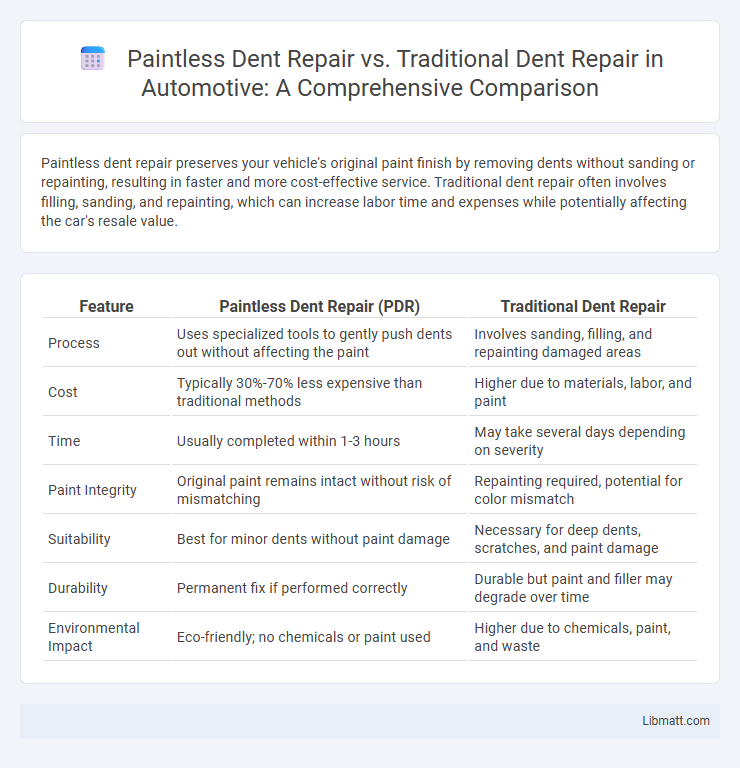Paintless dent repair preserves your vehicle's original paint finish by removing dents without sanding or repainting, resulting in faster and more cost-effective service. Traditional dent repair often involves filling, sanding, and repainting, which can increase labor time and expenses while potentially affecting the car's resale value.
Table of Comparison
| Feature | Paintless Dent Repair (PDR) | Traditional Dent Repair |
|---|---|---|
| Process | Uses specialized tools to gently push dents out without affecting the paint | Involves sanding, filling, and repainting damaged areas |
| Cost | Typically 30%-70% less expensive than traditional methods | Higher due to materials, labor, and paint |
| Time | Usually completed within 1-3 hours | May take several days depending on severity |
| Paint Integrity | Original paint remains intact without risk of mismatching | Repainting required, potential for color mismatch |
| Suitability | Best for minor dents without paint damage | Necessary for deep dents, scratches, and paint damage |
| Durability | Permanent fix if performed correctly | Durable but paint and filler may degrade over time |
| Environmental Impact | Eco-friendly; no chemicals or paint used | Higher due to chemicals, paint, and waste |
Introduction to Dent Repair Methods
Paintless dent repair (PDR) is a method that removes minor dents without affecting the vehicle's original paint, preserving its factory finish and resale value. Traditional dent repair involves filling and repainting damaged areas, which may alter the car's original appearance and can be more time-consuming and costly. Both techniques are essential in automotive repair, with PDR favored for small, shallow dents and traditional repair used for larger or more severe damage.
What is Paintless Dent Repair (PDR)?
Paintless Dent Repair (PDR) is a specialized technique used to remove minor dents and dings from a vehicle's body without affecting the original paint finish. Technicians use precise tools to gently massage the metal back to its original shape, preserving the factory paint and avoiding the need for fillers or repainting. This method is ideal for small dents caused by hail, door dings, or minor impacts, offering a quicker and often more cost-effective solution compared to traditional dent repair.
What is Traditional Dent Repair?
Traditional dent repair involves removing dents by sanding, filling, and repainting the affected area, which often requires extensive labor and paint matching to restore the vehicle's original appearance. This method can sometimes lead to a loss of factory finish and may increase the risk of color mismatch or paint peeling over time. It is widely used for severe dents or damage where the metal surface is significantly deformed or scratched.
Types of Damage Suited for Each Method
Paintless dent repair (PDR) is ideal for minor dents and dings caused by hail, door dings, or small creases where the paint remains intact. Traditional dent repair suits more severe damage such as deep dents, scratches, or areas with cracked or chipped paint requiring filling and repainting. Your choice depends on the dent's size, location, and paint condition for effective restoration.
Process Comparison: PDR vs Traditional Dent Repair
Paintless dent repair (PDR) uses specialized tools to gently massage dents from the vehicle's surface without affecting the original paint, preserving your car's factory finish. Traditional dent repair involves filling, sanding, and repainting damaged areas, which can be more time-consuming and costly. Your choice depends on dent size and paint condition, with PDR being ideal for minor dents and traditional repair necessary for severe or paint-damaged areas.
Cost Analysis: Paintless vs Traditional Repairs
Paintless dent repair (PDR) typically costs 50-70% less than traditional dent repair methods due to its minimally invasive process and lack of need for repainting. Traditional dent repair involves labor-intensive steps such as filling, sanding, and repainting, which increase both material and labor costs significantly. Choosing paintless dent repair can save your wallet while maintaining the vehicle's original paint finish and value.
Time Efficiency: Repair Duration Differences
Paintless dent repair typically requires significantly less time than traditional dent repair, often completing minor dent fixes within a couple of hours compared to several days needed for conventional methods. This efficiency stems from PDR's non-invasive process, which avoids sanding, painting, or filling, allowing quicker turnaround for your vehicle. Choosing PDR can minimize your vehicle's downtime, making it an optimal solution for fast dent repairs.
Impact on Vehicle Value and Paint Integrity
Paintless dent repair (PDR) maintains the vehicle's original paint and structural integrity, preserving its resale value by avoiding repainting and potential color mismatches. Traditional dent repair often involves sanding, filling, and repainting, which can diminish the vehicle's value due to altered factory finishes and increased risk of paint defects. PDR is preferred for minor dents as it ensures the vehicle retains its OEM paint integrity, positively impacting long-term vehicle value.
Environmental Considerations
Paintless dent repair (PDR) significantly reduces environmental impact by eliminating the need for harmful chemicals, paints, and fillers typically used in traditional dent repair. This eco-friendly method conserves resources and reduces hazardous waste, making it a sustainable option for vehicle maintenance. Your choice of PDR supports environmental preservation while effectively restoring your car's appearance.
How to Choose the Right Dent Repair Method
Choosing the right dent repair method depends on the size, location, and severity of the dent, with paintless dent repair (PDR) being ideal for minor dings and shallow dents where the paint remains intact. Traditional dent repair is more suited for extensive damage that involves paint scratches or deeper creases, requiring filler, sanding, and repainting to restore vehicle aesthetics. Your decision should factor in the cost, repair time, and the goal of preserving the original factory paint finish for optimal vehicle value.
Paintless dent repair vs Traditional dent repair Infographic

 libmatt.com
libmatt.com